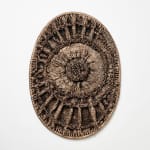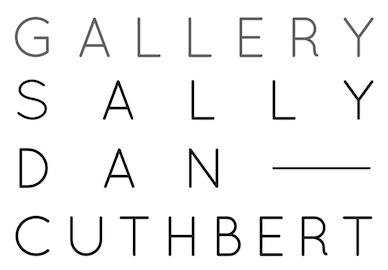Tammy Kanat
Breathe (Bronze), 2023
bronze
98 x 71 cm
Further images
Tammy Kanat is a weaver whose intuitive and abstracted pieces have become celebrated for their colour, inherent softness and vibrancy. Yet for Melbourne Art Fair she has created her first...
Tammy Kanat is a weaver whose intuitive and abstracted pieces have become celebrated for
their colour, inherent softness and vibrancy. Yet for Melbourne Art Fair she has created her first
major work in bronze, with qualities at odds with her usual sculptural pieces – heavy and hard
instead of soft and light. This new, intriguing medium attracts Kanat due to her inherent
curiosity: she says, ‘I love the unknown. It’s a great big leap.’
Breathe (bronze) is part of Kanat’s new series titled Breathe, in which highly textural works
evoke the rhythm of the push and pull process necessary to the construction of the work,
echoed in their oval forms and central circular motifs. Weaving requires strength, as textures
are hand-threaded in and out, particularly on this large scale, with knots also directed inward
and outward. She says, ‘The colours go into darkness and then come out again to lightness
and then back to darkness. It feels like the work is breathing.’
Yet in order to make the bronze, a textile work was created to scale, only to be ultimately
destroyed through the lost wax process necessary to cast it in bronze. Kanat asserts, ‘I am
attracted to the Buddhist idea of creating an object that is finally let go. And in this new
medium I don’t have to rely on colour. It forces a reliance on the form and becomes a forever
piece which will take all the weather, that is fearless. I’m pushing into investigating that further.
It is driven perhaps by, now being in my 50s, feeling more comfortable in my own skin, louder,
and keen to occupy more space.’
The translation is intriguing. The bronze interpretation carries the detail of the textiles and knots
with great accuracy, echoing the high-low profile of the form without the colour and soft edges.
The circular forms within and containing the bronze also amplify an organic quality that belies
the medium. In many ways, its texture distills the essential qualities of its textural beginnings; it
faithfully carries the memory of its genesis.
Conceptually too it reclaims the traditionally hard-edged modernist iteration of bronze (often
dominated by male artists) in this ‘feminine’ medium. And it remains a process in which Kanat
is physically fully invested in the collaboration with the foundry.
For Sally Dan-Cuthbert, ‘The bronze is a solid, weighty antidote to tapestry’s warp and weft
wrapped around air. Yet it continues to conduct the gentle qualities of woven fibres and
bleeding tones of Kanat’s signature work.’
The robust three dimensionality of Breathe is striking, with the central circular motif sitting
proud, and irregular lines radiating outward. It is heavy, but may be hung on the wall, or
displayed as a freestanding sculptural object. For Kanat, its ability to convey the essential
quality of textiles through the translation into bronze is central. It sits naturally within the
broader trajectory of her practice, and confirms that she continues to challenge the limits.
10 January 2024
Louise Martin-Chew
their colour, inherent softness and vibrancy. Yet for Melbourne Art Fair she has created her first
major work in bronze, with qualities at odds with her usual sculptural pieces – heavy and hard
instead of soft and light. This new, intriguing medium attracts Kanat due to her inherent
curiosity: she says, ‘I love the unknown. It’s a great big leap.’
Breathe (bronze) is part of Kanat’s new series titled Breathe, in which highly textural works
evoke the rhythm of the push and pull process necessary to the construction of the work,
echoed in their oval forms and central circular motifs. Weaving requires strength, as textures
are hand-threaded in and out, particularly on this large scale, with knots also directed inward
and outward. She says, ‘The colours go into darkness and then come out again to lightness
and then back to darkness. It feels like the work is breathing.’
Yet in order to make the bronze, a textile work was created to scale, only to be ultimately
destroyed through the lost wax process necessary to cast it in bronze. Kanat asserts, ‘I am
attracted to the Buddhist idea of creating an object that is finally let go. And in this new
medium I don’t have to rely on colour. It forces a reliance on the form and becomes a forever
piece which will take all the weather, that is fearless. I’m pushing into investigating that further.
It is driven perhaps by, now being in my 50s, feeling more comfortable in my own skin, louder,
and keen to occupy more space.’
The translation is intriguing. The bronze interpretation carries the detail of the textiles and knots
with great accuracy, echoing the high-low profile of the form without the colour and soft edges.
The circular forms within and containing the bronze also amplify an organic quality that belies
the medium. In many ways, its texture distills the essential qualities of its textural beginnings; it
faithfully carries the memory of its genesis.
Conceptually too it reclaims the traditionally hard-edged modernist iteration of bronze (often
dominated by male artists) in this ‘feminine’ medium. And it remains a process in which Kanat
is physically fully invested in the collaboration with the foundry.
For Sally Dan-Cuthbert, ‘The bronze is a solid, weighty antidote to tapestry’s warp and weft
wrapped around air. Yet it continues to conduct the gentle qualities of woven fibres and
bleeding tones of Kanat’s signature work.’
The robust three dimensionality of Breathe is striking, with the central circular motif sitting
proud, and irregular lines radiating outward. It is heavy, but may be hung on the wall, or
displayed as a freestanding sculptural object. For Kanat, its ability to convey the essential
quality of textiles through the translation into bronze is central. It sits naturally within the
broader trajectory of her practice, and confirms that she continues to challenge the limits.
10 January 2024
Louise Martin-Chew
Exhibitions
Melbourne Art Fair (Group Exhibition), Melbourne Convention Centre, Melbourne. 22 - 25 February, 2024.Tammy Kanat, Circle of Her, The Jewish Museum of Australia, 18 Sep 2025 - 22 Mar 2026








